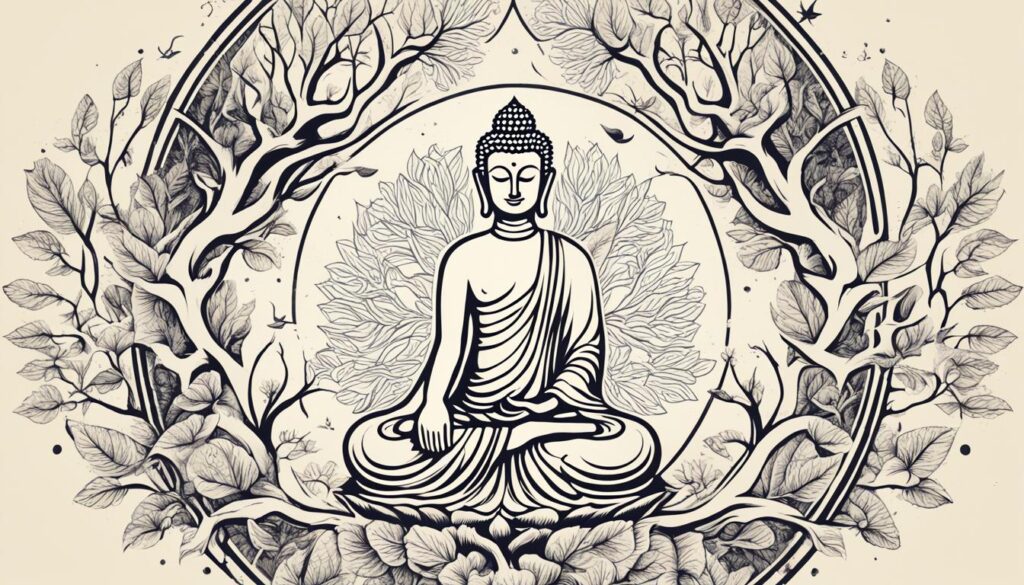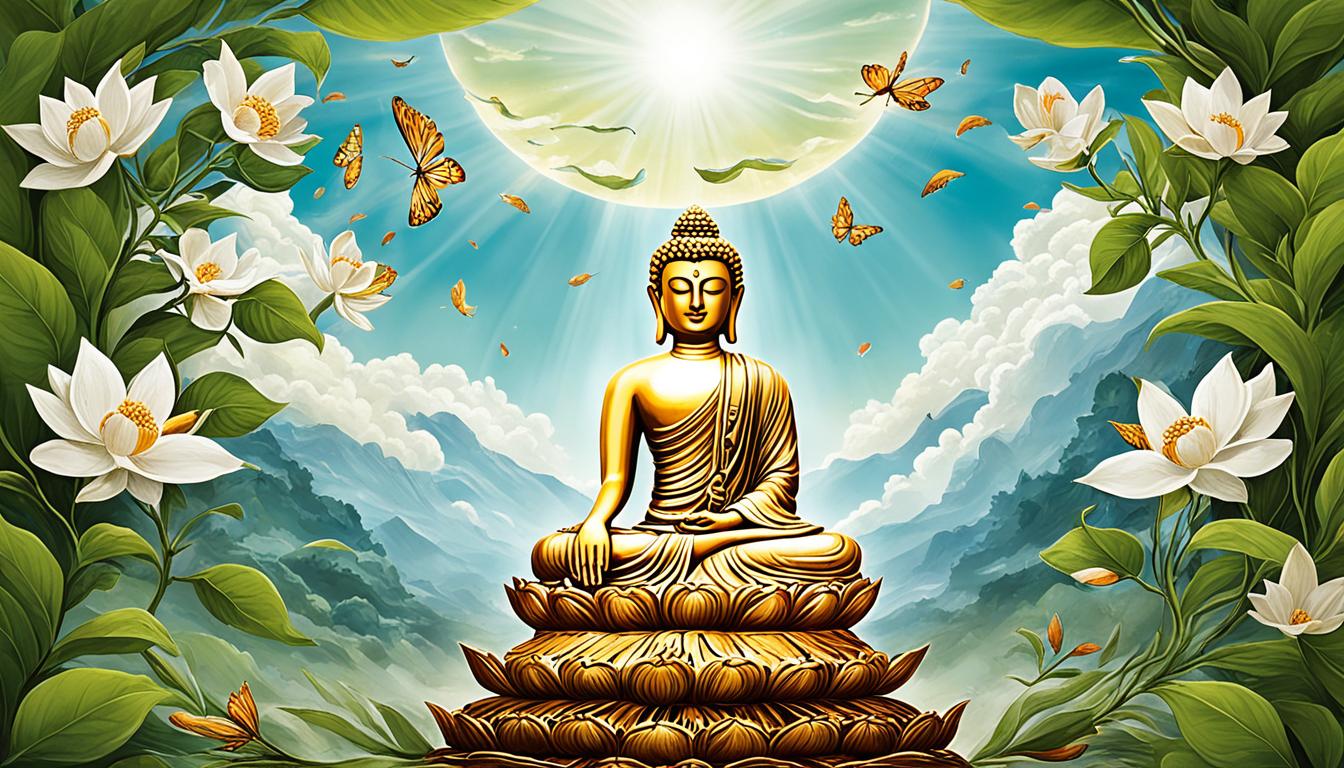“Thousands of candles can be lit from a single candle, and the life of the candle will not be shortened. Happiness never decreases by being shared.” – Buddha
Buddhism, with its rich history and profound teachings, offers a path to self-discovery and spiritual awakening. Rooted in the wisdom of the Buddha, this ancient philosophy provides powerful insights into the nature of existence and the pursuit of lasting happiness. By exploring the core beliefs of Buddhism, you embark on a transformative journey that can bring clarity, compassion, and inner peace.
Key Takeaways:
- Buddhism revolves around the Four Noble Truths, which explain the nature of suffering and how to overcome it.
- Karma and rebirth are fundamental concepts in Buddhism, emphasizing the consequences of our actions and the cyclical nature of existence.
- The Three Universal Truths and the Noble Eightfold Path provide a framework for understanding reality and cultivating wisdom.
- Siddhartha Gautama, known as the Buddha, founded Buddhism and offered teachings that resonate across different traditions.
- By exploring Buddhism’s core beliefs, you can gain insights into personal growth, societal harmony, and the pursuit of enlightenment.
The Four Noble Truths
The Four Noble Truths are the foundation of Buddhist teachings, encapsulating the core beliefs of Buddhism and providing a roadmap for attaining liberation from suffering. These truths offer profound insights into the nature of existence and the path to enlightenment. Let’s explore each truth in detail:
The First Truth: Acknowledging Suffering
The First Noble Truth recognizes the existence of suffering in the world. It acknowledges that life is inherently challenging, filled with pain, dissatisfaction, and impermanence. Whether it’s physical pain, emotional turmoil, or the universal experience of aging, illness, and death, suffering is an integral part of the human condition.
The Second Truth: Identifying the Cause of Suffering
The Second Noble Truth delves into the root cause of suffering. It reveals that desire and ignorance are the primary causes of our suffering. Attachment to desires and cravings, fueled by a lack of understanding of the true nature of reality, keeps us trapped in a cycle of dissatisfaction and suffering.
The Third Truth: Liberation from Suffering
The Third Noble Truth offers hope and relief from suffering. It proclaims that suffering can indeed be overcome, leading to a state of liberation known as Nirvana. Nirvana is a transcendent state of freedom from suffering, achieved through the eradication of desires and the cultivation of wisdom, compassion, and enlightenment.
The Fourth Truth: The Noble Eightfold Path
The Fourth Noble Truth outlines the Noble Eightfold Path, a practical and transformative guide to achieving liberation from suffering. The Noble Eightfold Path consists of eight interconnected principles:
- Right Understanding
- Right Thought
- Right Speech
- Right Action
- Right Livelihood
- Right Effort
- Right Mindfulness
- Right Concentration
The Noble Eightfold Path provides a comprehensive framework for leading a moral and mindful life, fostering wisdom, ethical conduct, mental discipline, and insight. By following this path, one can develop a deep understanding of reality and ultimately attain enlightenment.
By comprehending and embodying the Four Noble Truths, individuals can gain profound insights into the nature of suffering and the path to liberation. These core beliefs of Buddhism offer guidance, inspiration, and the potential for personal transformation.

Karma and Rebirth
In Buddhism, two essential doctrines play a significant role in understanding the nature of existence and the journey towards enlightenment: karma and rebirth. These beliefs form a fundamental part of the Buddhist philosophy, guiding individuals on their path to liberation from suffering.
Karma: The Law of Cause and Effect
In Buddhism, karma is the fundamental principle that governs the consequences of our actions. It follows the notion that every action we take, whether physical, verbal, or mental, generates corresponding results. Good actions lead to positive outcomes, while negative actions bring about suffering and unhappiness.
Your intentions and actions shape your future. What you sow through your thoughts, words, and deeds, you will inevitably reap. Buddhist teachings emphasize the importance of cultivating good karma by performing compassionate and virtuous actions, as they create harmony and well-being not only for oneself but also for others.

Rebirth: The Cycle of Life
Buddhism acknowledges the concept of rebirth, which suggests that beings are continuously born into various realms based on their karma. This cycle encompasses multiple lives, providing individuals with opportunities for growth and spiritual development.
The realm of human existence is considered precious in Buddhism. It offers a unique chance to attain spiritual enlightenment and liberation from suffering. The choices and actions made during this human life carry significant consequences, shaping the trajectory of future rebirths.
Rebirth offers the chance to break free from the cycle of suffering. By practicing mindfulness, compassion, and virtuous conduct, individuals can transcend the limitations of the human realm and progress towards spiritual awakening.
By understanding karma and rebirth, Buddhists strive to live harmoniously, cultivating positive intentions and actions that promote well-being and pave the way for a liberating journey towards enlightenment.
The Three Universal Truths and the Eightfold Path
One of the fundamental beliefs of Buddhism lies in its recognition of the Three Universal Truths. These truths encapsulate the essence of Buddhist teachings and provide valuable insights into the nature of reality and the interconnectedness of all things. The Three Universal Truths are:
- Nothing is Lost in the Universe: Buddhism teaches that nothing is permanent and that everything is interconnected. This truth reminds us that our actions and thoughts have consequences and that they ripple through the universe, impacting ourselves and others.
- Everything Changes: Buddhism acknowledges impermanence as a universal truth. It emphasizes that everything in the world, including our thoughts, emotions, and physical surroundings, is in a constant state of flux. By accepting this truth, one can cultivate resilience and find freedom from attachment.
- The Law of Cause and Effect: This truth emphasizes the concept of karma, the law of cause and effect. It states that our intentions and actions shape our future experiences. Through understanding the law of cause and effect, individuals can take responsibility for their actions and strive to cultivate positive karma.
An integral part of Buddhism’s core beliefs is the Eightfold Path, which serves as a roadmap to achieve enlightenment and liberation from suffering. The Eightfold Path encompasses moral conduct, mental development, and wisdom or insight. It consists of the following elements:
- Right Understanding: Developing a correct understanding of the nature of reality and the Four Noble Truths.
- Right Thought: Cultivating thoughts of renunciation, good will, and compassion.
- Right Speech: Speaking truthfully, avoiding harmful or divisive speech, and practicing mindful communication.
- Right Action: Engaging in ethical conduct, refraining from harming others, and promoting well-being.
- Right Livelihood: Earning a living in a way that aligns with moral values and does not cause harm.
- Right Effort: Exerting effort to cultivate wholesome qualities and overcome unwholesome tendencies.
- Right Mindfulness: Cultivating present-moment awareness and mindfulness in all activities.
- Right Concentration: Training the mind through meditation to develop deep states of concentration and insight.
The Eightfold Path provides a comprehensive guide for individuals seeking personal and spiritual growth. It encompasses various aspects of life and serves as a framework for living a meaningful and purposeful existence.

| The Three Universal Truths | The Eightfold Path |
|---|---|
| Nothing is Lost in the Universe | Right Understanding |
| Everything Changes | Right Thought |
| The Law of Cause and Effect | Right Speech |
| Right Action | |
| Right Livelihood | |
| Right Effort | |
| Right Mindfulness | |
| Right Concentration |
The Founder of Buddhism and Types of Buddhism
The founder of Buddhism is Siddhartha Gautama, who became known as the Buddha. He lived in India during the 5th century B.C. and dedicated his life to teaching others about the path to enlightenment. Buddhism has since evolved into different types, each with its own interpretations and practices, but they all share common core beliefs and teachings.
These are the three main types of Buddhism:
- Theravada Buddhism: This form of Buddhism is prevalent in Southeast Asia. It emphasizes the importance of individual enlightenment through meditation and adherence to the teachings of the Buddha.
- Mahayana Buddhism: Mahayana Buddhism is prevalent in East Asia, including countries such as China, Japan, and Korea. It places a greater emphasis on compassion and the pursuit of enlightenment for the benefit of all sentient beings.
- Tibetan Buddhism: Tibetan Buddhism is prevalent in Tibet and the surrounding regions. It incorporates elements of both Theravada and Mahayana Buddhism and also includes unique practices such as tantric rituals and the recognition of spiritual leaders known as Dalai Lamas.
Despite their differences, these types of Buddhism share a common goal of achieving enlightenment and liberation from suffering.
| Type of Buddhism | Region | Main Teachings |
|---|---|---|
| Theravada Buddhism | Southeast Asia | Individual enlightenment through meditation and adherence to the teachings of the Buddha. |
| Mahayana Buddhism | East Asia | Emphasis on compassion and the pursuit of enlightenment for the benefit of all sentient beings. |
| Tibetan Buddhism | Tibet and surrounding regions | Incorporates elements of Theravada and Mahayana Buddhism, along with unique practices such as tantric rituals. |

Notable Figures in Buddhism:
In addition to the Buddha, there are several other notable figures in Buddhism:
- Ashoka the Great: An Indian emperor who embraced Buddhism and played a key role in spreading its teachings.
- Thich Nhat Hanh: A Vietnamese Zen Buddhist monk, peace activist, and author known for his teachings on mindfulness and compassion.
- Dalai Lama: The spiritual leader of Tibetan Buddhism, believed to be the reincarnation of previous Dalai Lamas. The current Dalai Lama is Tenzin Gyatso.
These figures have made significant contributions to the dissemination and understanding of Buddhism throughout history.
Conclusion
Buddhism’s core beliefs revolve around the important tenets of alleviating suffering and seeking enlightenment. By embracing the fundamental beliefs of Buddhism, individuals can embark on a transformative journey filled with mindfulness, compassion, and the cultivation of wisdom.
At the heart of Buddhism lie the Four Noble Truths, which provide a profound understanding of suffering and its causes. These teachings offer essential doctrines for navigating life’s challenges and finding inner peace. The Noble Eightfold Path, consisting of right understanding, thought, speech, action, livelihood, effort, mindfulness, and concentration, serves as a compass to guide individuals towards enlightenment and liberation from suffering.
By exploring the central teachings of Buddhism and embracing its significant beliefs, individuals can unlock a deeper understanding of themselves and the world around them. Buddhism offers profound insights and guidance for personal growth, along with principles that foster societal harmony. Through the pursuit of Buddhism’s core beliefs, one can develop serenity, compassion, and a greater sense of purpose in life.
Embracing the core beliefs of Buddhism empowers individuals to live mindfully, cultivate compassion, and seek wisdom—a transformative journey that can lead to a more fulfilled and enlightened existence. By incorporating the teachings of Buddhism into your life, you can embark on a path of self-discovery, personal growth, and profound inner transformation.
FAQ
What are the core beliefs of Buddhism?
The core beliefs of Buddhism revolve around the Four Noble Truths, which address the nature of suffering and how to alleviate it. Buddhism emphasizes mindfulness, compassion, and the pursuit of enlightenment and liberation from suffering.
What are the Four Noble Truths?
The Four Noble Truths are the essence of Buddha’s teachings. They acknowledge the presence of suffering, identify desire and ignorance as the root causes of suffering, recognize that suffering can be overcome through achieving Nirvana, and outline the Noble Eightfold Path as a path to liberation from suffering.
What is karma and rebirth in Buddhism?
Buddhism teaches that karma is the law of cause and effect, where good actions bring happiness and bad actions bring unhappiness in the long run. Karma is determined by the intentions and actions of individuals throughout their lives. Buddhism also believes in the cycle of rebirth, where beings can be reborn into different realms based on their karma.
What are the Three Universal Truths and the Eightfold Path?
The Three Universal Truths in Buddhism are that nothing is lost in the universe, everything changes, and the law of cause and effect. These truths are foundational to understanding the nature of reality and the interconnectedness of all things. The Eightfold Path is the path to achieving enlightenment and liberation from suffering. It consists of principles such as right understanding, right thought, right speech, right action, right livelihood, right effort, right mindfulness, and right concentration.
Who is the founder of Buddhism and what are the types of Buddhism?
The founder of Buddhism is Siddhartha Gautama, who became known as the Buddha. He lived in India during the 5th century B.C. Buddhism has evolved into different types, including Theravada Buddhism, prevalent in Southeast Asia, Mahayana Buddhism, prevalent in East Asia, and Tibetan Buddhism, prevalent in Tibet and surrounding regions. Each type of Buddhism has its own interpretations and practices, but they share common core beliefs and teachings.

